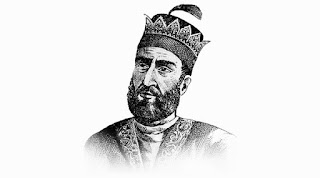 |
| Balban's Tomb at Mehrauli Archaeological Park |
After the death of Nasir-ud-din Mahmud of the Slave
dynasty of Delhi Sultanate in 1266, the line of the rulers from the family of Iltutmish
came to end. He was succeeded by his deputy Ghiasuddin Balban in whose hands
the real power of the state resided even during his lifetime.
Balban who was
also father-in-law of Nasir-ud-din Mahmud, probably murdered him to become the
sultan. Slave dynasty was fortunate enough to have Balban’s accession at the
time. This is because during the thirty years after the death of Iltutmish no
worthy ruler, except Razia, and that too for a brief period, ascended the
throne of Delhi sultanate. The rulers during the period were murdered by the
frivolous slaves. This dealt a body-blow to the slave dynasty. The condition of
the sultanate was such that a strong and stern ruler was the need of the hour.
And he fit the bill well.
Since internal rebellions had to suppressed Balban took
steps in the direction of strengthening the army which involved introduction of
some changes in the armed forces and increasing their numerical strength. Balban
meted out severest punishment to the Mewat Rajputs inhabiting the area round
Alwar in Rajasthan. The Mewatis were danger to the order of the capital. After clearing
the jungles in the vicinity of Delhi, ‘a hundred thousand males above twelve’ of
them were murdered. A fort at Gopalgir was
built by Balban who put several posts near the city of Delhi in charge of
Afghan officers.
In 1267
Balban crushed the brigands in the Doab who had their heydays in their
strongholds at Kampil, Patiali and Bhojpur where Balban erected forts besides repairing
the fort of Jalali. Balban also suppressed the rebellions in Katehr (now in
Rohilkhand). The refractory hill tribes of the mountains of Jud were also suppressed
by Balban.
Balban
did not lose sight of the Mongol danger that was lurking in the north-west
frontier of the kingdom. Balban’s cousin Sher Khan Sunqar was ably defending
the frontier. However, Balban grew suspicious of him and got him murdered. His death
left the field open for the Mongols to indulge in their incursions of the frontier
tracts. Prince Muhammad, Sultan’s eldest son, was governor of Multan to check the
Mongol menace. Bughra Khan, his second son, was placed in charge of the
territories of Samana and Sunam. In 1279 they, together with Malik Mubarak Bektars from Delhi, successfully
repulsed the Mongol invasion.
However,
in A.D. 1285 Mongols under their leader Tamar invaded Punjab. Prince Muhammad proceeded
towards Lahore and Dipalpur and was killed during his fight against the Mongols.
He was given the title of Shahid, "the Martyr" and came to be known
as Khan-i-Shahid, (the Martyr Prince).
Crushing Tughril Khan’s rebellion in Bengal
In 1279,
Tughril Khan, the Sultan's deputy in Bengal, rose in rebellion against him.
Balban
sent an army under Amir Khan who was defeated by the rebel governor. This infuriated
Balban so much that Amir Khan was hanged over the gate of Delhi on his orders. Another
military campaign under Malik Targhi in the next year met the same fate. Now
the Sultan himself decided to proceed to Bengal. Accompanied by his son, Bughra Khan, he headed
towards Bengal. Tughril Khan was killed. Bughra Khan was appointed governor of
the Bengal province.
After
an iron rule of about twenty-two years, Balban died in A.D. 1287. His tomb and
that of his son Prince Muhammad (Khan-i-Shahid) are located in Mehrauli
Archaeological Park in Delhi. The dilapidated tomb betrays no hint of Balban's fame as one of the most powerful rulers of medieval India.
Kingship
under Balban
During the weak rule of Balban’s
predecessors, the institution of kingship had lost respect and there was danger
of Sultans being considered as imbecile by the people. To restore the dignity
of the crown, Balban a proponent
of the dignified mode of living, etiquette
and rituals,
organized his court after the manner of the old Persian monarchs. This was done
to give legitimacy to his rule which may be contested by the rebels due to the
fact of his being a salve. During his rule the splendour and glory of the royal
court reached heights and gave asylum to some fifteen exiled prices from central
Asia. Ziauddin Barani, author of Tarikh-i-Firuz Shahi, writes, “Fear and awe of him took possession of all men`s hearts.”
Balban
appointed only men of elite class to important posts. He ensured the strict
observance of the etiquette of the court. Those who attended his court were supposed to observe sizda (prostration before the sultan) and paibod (kissing his feet) (both
un-Islamic practices). Balban was the first Indian ruler to introduce the celebration
of the Persian new year (nao-roz) in India.
Balban called himself Naib-i-Khudai or Deputy of the God.
He created Diwan-i-Arz or the Department of Military Affairs.




+Purushottam+Das+Tandon.jpg)


